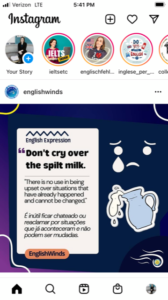Fiona Wattam at IELTS Etc. recently put up an excellent post on some of the trickier aspects of using idioms well in IELTS essays, and it got me thinking about that topic as well. I think it’s fair to say that it’s a very popular subject: a quick Google search turns up almost four million results, some of which offer very contradictory advice.
I spent a lot of time thinking about idioms while writing (and repeatedly rewriting) that section of my IELTS grammar book, and at a certain point—perhaps after my tenth revision?—I came to a realization and finally managed to put the issue into words: using idioms is not the same as speaking or writing idiomatically.
I realize that statement might sound very contradictory so, to use a frequently memorized Task 1 General Training phrase, allow me to explain:
Essentially, the problem lies in the similarity of the terms idiom and idiomatic. One could very reasonably assume that they refer to the same thing, but in reality… not quite.
Generally speaking, idioms are fixed phrases in which words are frequently used in non-literal ways. For example, the American idiom out of left field (a baseball reference) refers to something said or done very unexpectedly.
The word idiomatic, however, does not just mean “filled with idioms.” Rather, it is a more general term that describes language in which words are put together naturally, the way a native speaker would arrange them.
Now, idiomatic language may contain idioms in the sense of fixed, non-literal phrases—indeed, it often does, since English makes considerable use of these expressions—but that is not necessarily the case. Rather, using language idiomatically is a matter of using the type of language that is appropriate to a given situation. This is what you need to be able to do to receive high marks in Writing and Speaking.
You can also think of it this way: Just using idioms will not make you sound more like a native speaker. Using idioms the way native speakers use idioms will make you sound more like a native speaker.
As Fiona pointed out in her post, this is not a simple task. It involves, among other things, (in)formality, age, social status, and what type of language is currently “in”.
That’s a lot of factors to take into account, and unfortunately there isn’t any room to get things wrong. Idioms are idioms because they’re fixed by definition: you can’t make tiny changes such as adding, changing, or omitting articles, or making singular nouns plural, without creating constructions that sound obviously and immediately wrong to a native ear.
To take just a few examples I grabbed from social media:

It should be, “There’s no use crying over spilt/spilled milk” (no “the”).
Or this: 
It should be “as old as the hills” (outdated; almost never used).

This should be, “It runs in the family.” The present continuous cannot replace the simple present.
Misusing idioms in ways they’re misused above will actually make your English sound less natural than not using idioms at all.
To add yet another layer of confusion, idiomatic language is often associated with informality, but it can actually be used in more formal situations as well. The two types of situations require different types of constructions, however. In Task 2 essays, the real challenge is using idiomatic language that is appropriate for formal contexts.
One of the biggest problems here is that the idioms ESL students learn are in fact clichés, or phrases that are extremely overused and that make a writer or speaker sound unoriginal (and sometimes very old-fashioned). These types of phrases are also informal and should not be used in Task 2 or Task 1 Academic Training essays. Unfortunately, most IELTS idiom lists are filled with them.
Common examples include it’s a piece of cake (to describe something very easy); every cloud has a silver lining (something good can result from something bad); once in a blue moon (very rarely); and every coin has two sides, or there are two sides to every story (people can interpret the same situation in opposite ways).
It’s not a bad idea to be familiar with these phrases since you will probably encounter them sooner or later, but you shouldn’t go out of your way to use them.
On the other hand, idiomatic language associated with more formal situations tends to fall more into the category of collocations—words or phrases that are typically used together by native speakers. A few examples from this post include take into account, yet another layer, and could reasonably assume.
Of course, things aren’t so simple here either: some collocations are informal only; others can be used in both formal and informal situations; and still others are primarily used in formal situations.
This also goes beyond “phrasal verbs = informal; single-word verbs = formal”. Some phrasal verbs are in fact perfectly acceptable in formal situations, while some single-word verbs are perfectly acceptable in informal ones.
For example, consider the following example (adapted from a real essay):
Some of my friends speak highly of their employers because they feel their companies show an interest in workers’ wellbeing by offering the facility to hit the gym.
The writer gets it right in the first part of the sentence: speak highly of is an outstanding example of a formal-only idiom/collocation. In an informal context, a person might say I’ve heard such great things about you! This is Band 7+ vocabulary usage.
The problem occurs at the end of the sentence: the phrase hit the gym is something that would normally be said in casual speech, e.g., Ok, guys, I’m outta here. I’m gonna hit the gym for an hour or so and then head home.
In addition, the writer refers to friends and companies, plural, so the plural facilities is more natural than the singular facility here. (And if the writer were to use the singular, a rather than the would need to be used before facility since there are many such facilities in existence.)
The student has a good general grasp of English, but the details aren’t quite right. Errors like this throughout an essay can easily knock an overall Writing score into 6.5 range.
Some examples of more idiomatic—that is, more formal—constructions would be as follows:
Some of my friends speak highly of their employers because they feel their companies show an interest in workers’ wellbeing by offering workout facilities.
Or:
Some of my friends speak highly of their employers because they feel their companies show an interest in workers’ wellbeing by providing facilities for them to work out. (Note that workout is one word as a noun, two as a verb.)
Or:
Some of my friends speak highly of their employers because they feel their companies show an interest in workers’ wellbeing by making workout facilities available to them.
Or even:
Some of my friends speak highly of their employers because they feel their companies show an interest in workers’ wellbeing by making exercise facilities available on-site.
Note that while none of the rewritten phrases contains an idiom in the sense of hit the gym, they are all far more idiomatic than the original version.
In the Speaking test, and in Task 1 General Training letters to friends, this is reversed: you should absolutely make an effort to use informal collocations such as hit the gym (e.g., Working out isn’t exactly my favorite thing to do, but I make an effort to stay in shape. I try to hit the gym at least a couple of days a week after work.) But for purposes of the IELTS, you can probably skip most idiom lists (with perhaps a few exceptions) and focus instead on “collecting” collocations when you read or listen to English produced by native speakers.
Yes, this requires much more active though; however, you’re much more likely to 1) remember various expressions and 2) use them correctly if you can associate them with a specific context. Your goal is always to write or speak the type of English that is most appropriate at a particular moment, and that’s something no word list can possibly teach you.

Thank you for you guide